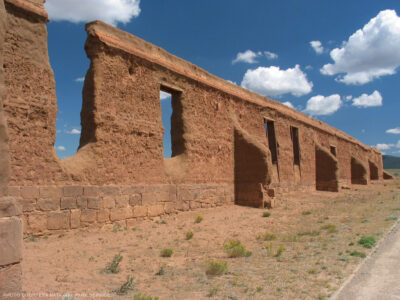
Flippered, goggled, and tanked, George F. Bass Gr’64 dove into the Mediterranean Sea and made history. Never before had an archaeologist—or an archeology student, as Bass then was—gone to the bottom of the sea to participate in an excavation.
The year was 1960 and the place was Cape Gelidonya, Turkey. Bass, who was earning his PhD at Penn, had traveled there at the behest of Rodney Young, his archaeology professor and the curator of Penn Museum’s Mediterranean section.
“One day, Rodney said, ‘Someone found a Bronze Age shipwreck in Turkey,’” Bass recently recalled. “Want to go see what they are doing?’”
Bass wasn’t expected to scuba dive to the excavation. In those days, archaeologists waited in a dry spot for divers to retrieve artifacts. Bass didn’t see the logic in that. “Conducting the excavation is the archaeologist’s job,” he said. “If the shipwreck is in the water, why would I stay on land?”
After six scuba diving lessons at a Philadelphia YMCA, Bass left for Turkey. Shortly thereafter, he was on a boat in the Mediterranean. This would be his first open sea dive. “I wasn’t nervous,” Bass said. “I was excited to get into the water.”
Fifty years after that first plunge, Bass returned to the Penn Museum to receive the Lucy Wharton Drexel Medal, established in 1889 to recognize exceptional work in the field of archeology. Bass’s field lies at the bottom of the sea. The man who went into the Mediterranean a Penn grad student emerged as the father of a new sub-discipline: nautical archeology.
“George altered archeological chronologies right and left throughout the Mediterranean as a consequence of the shipwrecks that he discovered, which were very precisely dateable and loaded with cargo,” said C. Brian Rose, a Penn professor of classical archeology who is also deputy director of the Penn Museum and curator-in-charge of its Mediterranean section.
“There was information about trading patterns, and the economic climate of particular periods, that would have been impossible to pull from other archeological sites or investigations. George revolutionized the way we think of ancient economy in the Mediterranean.”
It took Bass decades to accomplish that. He earned his PhD in 1964, and became an assistant professor of classical archeology at Penn. Bass taught graduate courses and a two-year seminar on Aegean pre-history, which he considers one of his academic accomplishments. “I’m so proud of it. You know, the top Bronze Age archaeologists, they all went to Penn, and they all came out of my course. But that’s completely forgotten because of the underwater thing.”
The “underwater thing” dominated Bass’s career. While at Penn, he developed techniques, tools, and submersible chambers that advanced nautical archeology out of its infancy. In 1972, Bass left Penn to found what is now called the Institute of Nautical Archaeology, an international organization that conducts underwater excavations on (or just off) four continents.
Yet when he sat in that boat near Cape Gelidonya and prepared for his first dive, Bass had no way of knowing what he would find. Gold? Pottery? Weapons? What would the items reveal about human history? Would they be valuable? To whom would they belong?
That question is still being asked. Bass’s award ceremony launched a symposium held at the Penn Museum and sponsored by the Penn Cultural Heritage Center titled “Who Owns Underwater Cultural Heritage?”
Experts came from Spain, Slovenia, Italy, Israel, and five other countries to share information and debate the UNESCO Convention on the Protection of Underwater Cultural Heritage. Ratified in 2001, the accords went into effect in 2009. They attempt to legislate what underwater treasures belong to which countries. It’s not a simple task.
Say a Portuguese-built ship that sailed from Greece in 1652 is found by an American research team in Egyptian waters with $40 million of gold bullion. To whom does the gold belong?
For decades, if not centuries, the rule has been something like “finders keepers.”
The UNESCO accords provide a legal framework to resolve ownership issues. Once a find has been made, its discoverers are supposed to report it to the UN, which will mediate ownership rights among countries who provide “verifiable links” to the archeological finds.
Theoretically, countries could share the finds and the knowledge they reveal. Realistically, that depends on the booty. While they might part with glass and pottery shards, few countries are eager hand over $40 million worth of gold. Furthermore, many finds are made not by scholarly expeditions but by treasure hunters.
“One day, treasure hunting will, I hope, be considered as old-fashioned as hunting elephants for ivory,” Bass said. “There is nothing romantic about it. It’s just destruction.”
Treasure hunters were not represented at the Penn conference, but it’s safe to assume that they have no intention of abiding by the UNESCO accords.
Neither does the United States. While 31 countries have ratified the accords—primarily those located in the Mediterranean basin, which was UNESCO’s focus—the U.S. has not and, apparently, will not.
“There were sound reasons for the United States government not signing the UNESCO accords, including concerns over the applications of certain legal principles,” explained James P. Delgado, president and CEO of the Institute of Nautical Archeology, the organization Bass founded. Delgado is also the former head of the U.S. Maritime Preservation Program.
One complicating fact is that the federal government doesn’t have jurisdiction over all domestic waters. The Abandoned Shipwreck Act of 1987, which Delgado helped write, says that states have dominion over shipwrecks found in state waters, and that American Indians hold sway over the contents of waters that fall under their purview. The UNESCO accords mandate that signatory governments police their waters and prosecute treasure-hunting interlopers. For the U.S., that could mean a lot of policing—and, potentially, ceding control over some underwater finds.
“We’re not just talking about the contiguous states, Alaska and Hawaii,” Delgado said. “That act applies to all of the American territories.” Put all those together, and the magnitude of what could be found beneath the seas, and claimed by the U.S., begins to emerge.
Just the same, discoveries in U.S. waters are unlikely to pose quite such thorny ownership questions as underwater finds in the Mediterranean, which is shared by so many countries.
Consider one of the finds presented at the Penn conference. Late Iron Age coins, Augustan medallions, Julio-Claudian amphorae, and a Celtic sword, in its scabbard, were found in the rivers of Slovenia—a young country whose territory has variously belonged to the Byzantine empire, the Hapsburg monarchy, the Napoleonic empire, and more than half a dozen other political entities.
That’s all the more reason, in the view of many conference participants, to privilege nautical archaeologists over treasure seekers. Consider what Bass found half a century ago off Cape Gelidonya: three tons of medieval Islamic glass, the largest collection in existence. It took 30 years of work for Bass and his team to excavate the glass, piece it together, and uncover its archeological secrets.
“And now, it’s in a museum, and we will continue to find new technologies that enable us to learn more about what we find in the water,” Bass said. “Who knows what lies beneath?”
—Melissa Jacobs C’92




